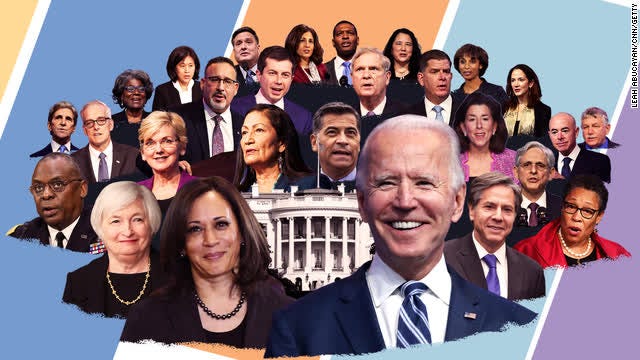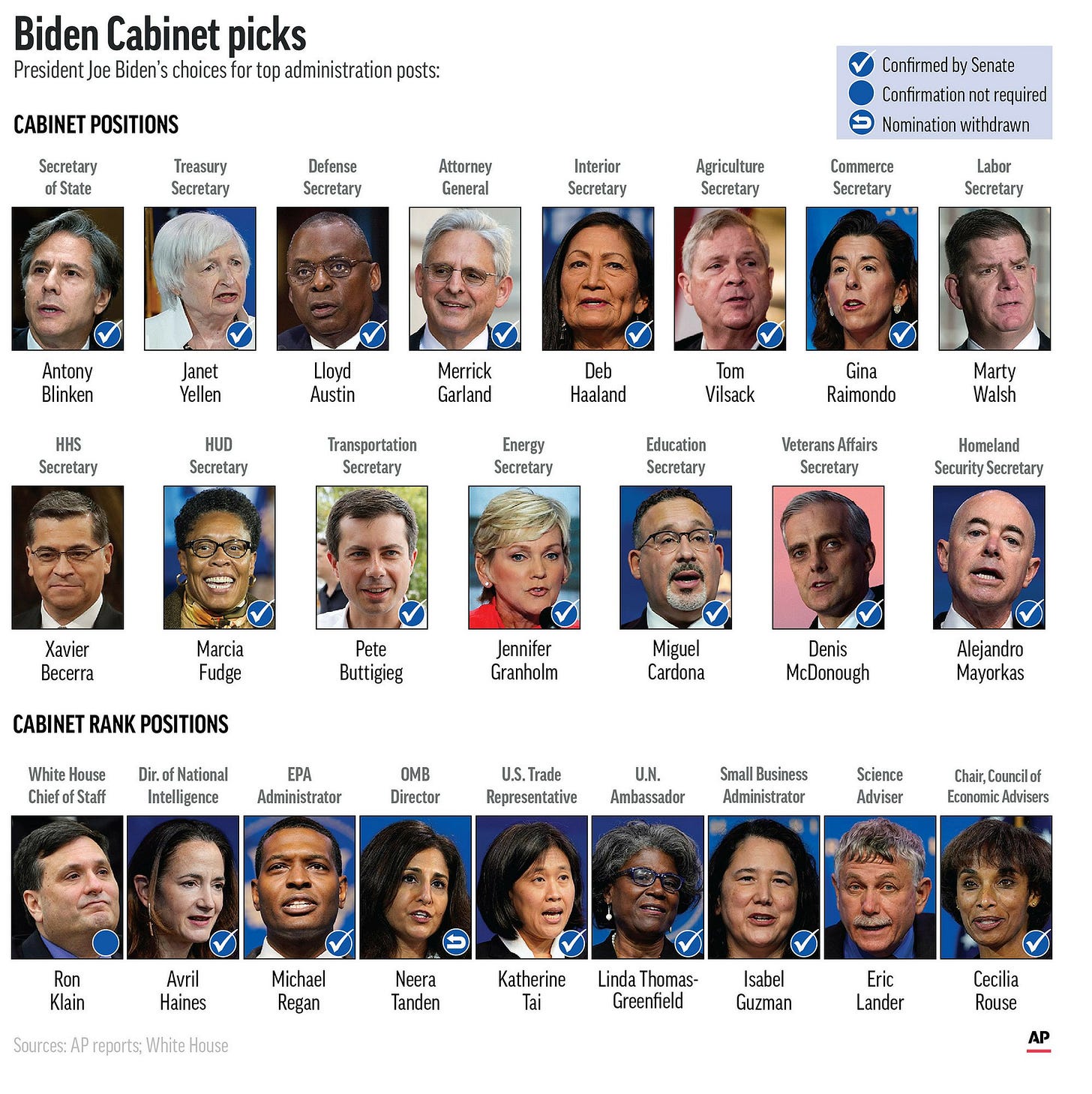Interesting Facts about the President’s Cabinet
A Constitutional Tradition Started by George Washington
Issue #144 Government October 6, 2022
No ads or annoying popups ever! So instead, please see the important information at the bottom of this post. Please keep those “Likes” and comments coming! Thanks!
We’ve all heard of the Cabinet for the president, but exactly what is the cabinet and what does it do?
The Cabinet of the United States is the official advisory body to the President Of The United States (POTUS) and is part of the Executive Branch of the government. The term “cabinet” is thought to have come from the Italian word cabinetto, which means “small private room.” In this room, the government leader can meet in a smaller room with the advisers to have more privacy and to limit interruptions. In the 18th century, under King George I, who surprisingly spoke very little English, the British started calling this group of advisors the “Cabinet.” President George Washington started the tradition of having a group of advisers and President James Madison was the first to formally call the group “The Cabinet.”
The Cabinet is not officially part of the U.S. Constitution, which only states that the President can appoint officers of executive advisers. The role of the Cabinet is only inferred from the Constitution in the Opinion Clause (Article II, Section 2, Clause 1), which states that these persons are to provide advice to the president.
President George Washington started the constitutionally approved Cabinet meetings with four members. Since then, the Cabinet has been expanded to its now 25 members.
Although chair of the Cabinet, the President is not an official member of the body. The Vice President is a member of the Cabinet, along with the 24 members, which include 15 department heads and 9 Cabinet-level members, most of whom have received Senate confirmation. Except for the Vice President, none of the Cabinet members are elected. They are all appointed by the President.
The Vice President was not regularly included as a member of the Cabinet until the 20th century.
President John F. Kennedy appointed his brother, Robert Kennedy, as his attorney general, which was considered highly unusual. A few years later, under 5 U.S.C. § 3110 (also known as the 1967 Federal Anti-Nepotism statute), federal officials were henceforth prohibited from appointing their immediate family members to certain governmental positions, including those in the Cabinet.
Although the Cabinet does not have any collective executive powers or functions of its own and no votes are taken. Its purpose is purely advisory except for one specific and important function added in the 25th Amendment: the Vice President is authorized, along with a majority of the heads of the executive departments, to declare the president “unable to discharge the powers and duties of his office.”
In January 2021, after the first impeachment of Donald Trump and the insurrection at the Capitol on January 6, there was serious discussion within the Cabinet to invoke the 25th Amendment against Trump.
Any of the Cabinet members can become president!
The Cabinet Secretaries are actually in the presidential line of succession, starting with the Secretary of State (currently Anthony Blinken), after the Vice President (currently Kamala Harris), the Speaker of the House of Representatives (currently Nancy Pelosi), and the Speaker Pro Tempore of the Senate (currently Patrick Leahy), the first three officials in the line of succession.
The “Big Four” Cabinet members, those who sit closest to the President during Cabinet meetings and are often the first nominated by the President (even before the official inauguration) are the Secretary of State (Anthony Blinken), the Secretary of the Treasury (Dr. Janet Yellen), the Secretary of Defense (former 4-Star General Lloyd Austin), and the Attorney General (Merrick Garland—also known as the Secretary of Justice).
After these four, the remaining Cabinet members are seated in order of when their respective departments were approved since 1787.
The Cabinet of President Joe Biden is the most diverse in American history.
Only the Vice President is officially the president after ascension; all the others would be considered acting president. Whenever the Vice President and members of the Cabinet are assembled together in one place, such as at the inauguration or the State of the Union address, one member of the Cabinet is randomly selected to be the “Designated Survivor” and not be in attendance at the event, just in case everyone else somehow is killed or otherwise incapacitated. The “Designated Survivor” is then the official acting president until another election is held.
Any Cabinet member can become president if they are otherwise constitutionally eligible. Energy Secretary Jennifer Granholm, for example, is not eligible to be president because she was born in Canada.
Cabinet members cannot also be members of Congress.
How the President’s Cabinet is chosen
The members of the President’s Cabinet and Executive Office of the President (heads of other agencies) are appointed to the Cabinet by the President and most are then approved by the Senate. They meet in a “small private room” adjacent to the Oval Office.
The heads of the executive departments and of all federal agencies are nominated by the president and presented to the Senate for confirmation or rejection by a simple majority.
Neither the elected Vice President nor the appointed White House Chief of Staff (currently Ron Klain) requires Senate confirmation for their Cabinet positions.
The members of the Cabinet serve at the pleasure of the President and can be dismissed at any time without needing approval by the Senate. Because the Cabinet members are federal public officials, they are all subject to impeachment by the House of Representatives and trial by the Senate for “treason, bribery, or other high crimes and misdemeanors.”
Did you learn anything new about the President’s Cabinet? Let us know in the comments!
Help us to grow!
“We Are Speaking” is a reader-supported publication. To receive new posts and podcast episodes and to support our work, consider becoming a free or paid subscriber. We publish 7 days/week and 28+ issues/month. You. can upgrade your free subscription to the paid level. It costs monthly and annual paid subscribers less than 35¢ an issue. Thank you!

Thank you for checking out some of the books and businesses of the TeamOwens313 Global Creative Community:
Detroit Stories Quarterly (DSQ) Afro-futurism Magazine
The Mayonnaise Murders: a fantasy mystery novel by Keith A. Owens
The Global Creative Community Membership Site: Networking and Monthly/Weekly Topics for Independent Writers and Creative and Solo Professionals
The Global Creative Community Brand and Marketing Academy: Training and Group Coaching for Independent Writers and Creative and Solo Professionals
Pam’s Branding and Marketing Articles for Independent Writers and Creative and Solo Professionals on LinkedIn
“We Are Speaking” is a reader-supported publication. To receive new posts and podcast episodes and to support our work, consider becoming a free or paid subscriber.





